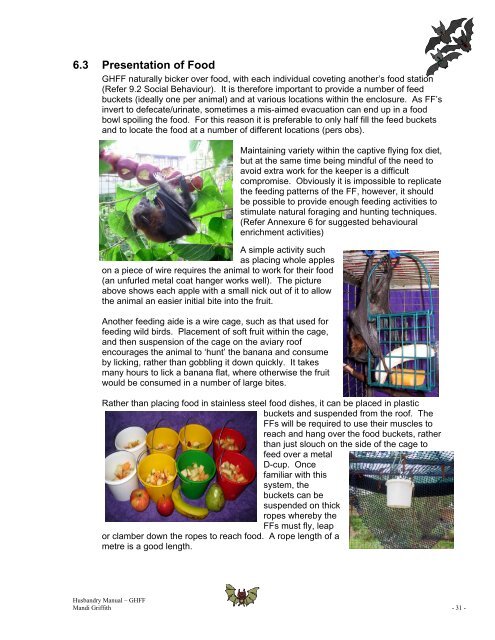Husbandry Manual for Grey- Headed Flying Fox - Nswfmpa.org
Husbandry Manual for Grey- Headed Flying Fox - Nswfmpa.org
Husbandry Manual for Grey- Headed Flying Fox - Nswfmpa.org
You also want an ePaper? Increase the reach of your titles
YUMPU automatically turns print PDFs into web optimized ePapers that Google loves.
6.3 Presentation of Food<br />
GHFF naturally bicker over food, with each individual coveting another’s food station<br />
(Refer 9.2 Social Behaviour). It is there<strong>for</strong>e important to provide a number of feed<br />
buckets (ideally one per animal) and at various locations within the enclosure. As FF’s<br />
invert to defecate/urinate, sometimes a mis-aimed evacuation can end up in a food<br />
bowl spoiling the food. For this reason it is preferable to only half fill the feed buckets<br />
and to locate the food at a number of different locations (pers obs).<br />
A simple activity such<br />
as placing whole apples<br />
on a piece of wire requires the animal to work <strong>for</strong> their food<br />
(an unfurled metal coat hanger works well). The picture<br />
above shows each apple with a small nick out of it to allow<br />
the animal an easier initial bite into the fruit.<br />
Another feeding aide is a wire cage, such as that used <strong>for</strong><br />
feeding wild birds. Placement of soft fruit within the cage,<br />
and then suspension of the cage on the aviary roof<br />
encourages the animal to ‘hunt’ the banana and consume<br />
by licking, rather than gobbling it down quickly. It takes<br />
many hours to lick a banana flat, where otherwise the fruit<br />
would be consumed in a number of large bites.<br />
Maintaining variety within the captive flying fox diet,<br />
but at the same time being mindful of the need to<br />
avoid extra work <strong>for</strong> the keeper is a difficult<br />
compromise. Obviously it is impossible to replicate<br />
the feeding patterns of the FF, however, it should<br />
be possible to provide enough feeding activities to<br />
stimulate natural <strong>for</strong>aging and hunting techniques.<br />
(Refer Annexure 6 <strong>for</strong> suggested behavioural<br />
enrichment activities)<br />
Rather than placing food in stainless steel food dishes, it can be placed in plastic<br />
buckets and suspended from the roof. The<br />
FFs will be required to use their muscles to<br />
reach and hang over the food buckets, rather<br />
than just slouch on the side of the cage to<br />
feed over a metal<br />
D-cup. Once<br />
familiar with this<br />
system, the<br />
buckets can be<br />
suspended on thick<br />
ropes whereby the<br />
FFs must fly, leap<br />
or clamber down the ropes to reach food. A rope length of a<br />
metre is a good length.<br />
<strong>Husbandry</strong> <strong>Manual</strong> – GHFF<br />
Mandi Griffith - 31 -

















